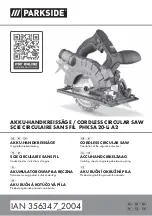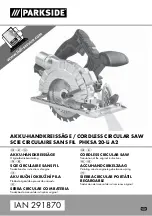
GB
- 27 -
7. Using the saw
7.1. ON/OFF switch (Fig. 1)
•
To turn the saw on, press the green button
“I”. Wait for the blade to reach its maximum
speed of rotation before commencing with the
cut.
•
To turn the machine off again, press the red
button “0”.
7.2. Cutting depth (Fig. 1)
Turn the hand crank (8) to set the blade (4) to the
required cutting depth.
Turn anti-clockwise:
larger cutting depth
Turn clockwise:
smaller cutting depth
7.3. Parallel stop
7.3.1. Stop height (Fig. 11-14)
•
The parallel stop (7) supplied with the bench-
type circular saw has two different guide
faces.
•
For thick material you must use the stop rail
(23) as shown in Fig. 12, for thin material you
must use the stop rail as shown in Fig.13.
•
To change over the stop rail (23) to the lo-
wer guide face you have to slacken the two
knurled screws (26) in order to disconnect the
stop rail (23) from the holder (24).
•
Remove the two knurled screws (26) through
the one slot (27) in the stop rail (23) and in-
sert in the other slot (25).
•
Remount the stop rail (23) on the holder (24).
•
The procedure for changing over to the high
guide face is similar.
7.3.2. Cutting width (Fig. 14)
•
The parallel stop (7) has to be used when
making longitudinal cuts in wooden workpie-
ces.
•
The parallel stop (7) can be mounted on eit-
her side of the saw table (1).
•
The parallel stop (7) has to be mounted in the
guide rail (28) of the saw table (1).
•
The parallel stop (7) can be set to the requi-
red dimension with the help of the scale (22)
on the guide rail (1).
•
You can clamp the parallel stop in the requi-
red position by pressing the eccentric lever
(12).
7.3.3. Setting the stop length (Fig. 11-14)
•
The stop rail (23) can be moved in longitudi-
nal direction in order to prevent the workpiece
from becoming jammed.
•
Rule of thumb: The rear end of the stop co-
mes up against an imaginary line that begins
roughly at the center of the blade and runs at
an angle of 45° to the rear.
•
Set the required cutting width
- Slacken the knurled screws (26) and push
the stop rail (23) forward until it touches the
imaginary 45° line.
- Retighten the knurled screws (26).
7.4. Cross stop (Figure 15)
•
Slide the cross stop (14) into the groove (21)
of the table.
•
Slacken the knurled screw (20).
•
Turn the cross stop (14) until the arrow points
to the angle required.
•
Retighten the knurled screw (20).
Important!
•
Do not push the stop rail (23) too far toward
the blade.
•
The distance between the stop rail (23) and
the blade (4) should be approx. 2 cm.
7.5. Setting the angle (Fig. 16)
•
Undo the locking grip (9).
•
Adjust the angle of the saw blade by pressing
the hand wheel (8) towards the machine and
turning it at the same time.
•
Lock the locking grip.
8. Operation
Warning!
•
After every new adjustment we recommend
you to make a trial cut in order to check the
new settings.
•
After switching on the saw, wait for the blade
to reach its maximum speed of rotation before
commencing with the cut.
•
Take extra care when starting the cut!
•
Never use the equipment without the suction
function.
•
Regularly check and clean the suction chan-
nels.
•
The cap on the blade guard can be removed
in order to be able to connect a suction hose
to the blade guard.
Anl_TC_TS_2025_1_U_2025_1_ECO_SPK9.indb 27
Anl_TC_TS_2025_1_U_2025_1_ECO_SPK9.indb 27
13.04.2018 11:41:56
13.04.2018 11:41:56
















































